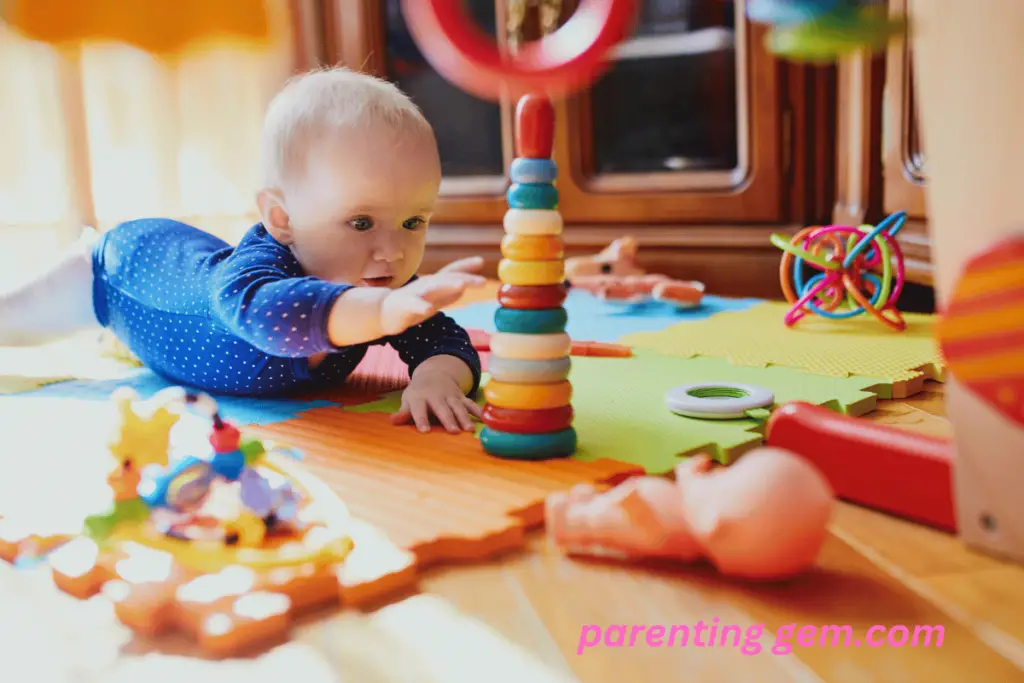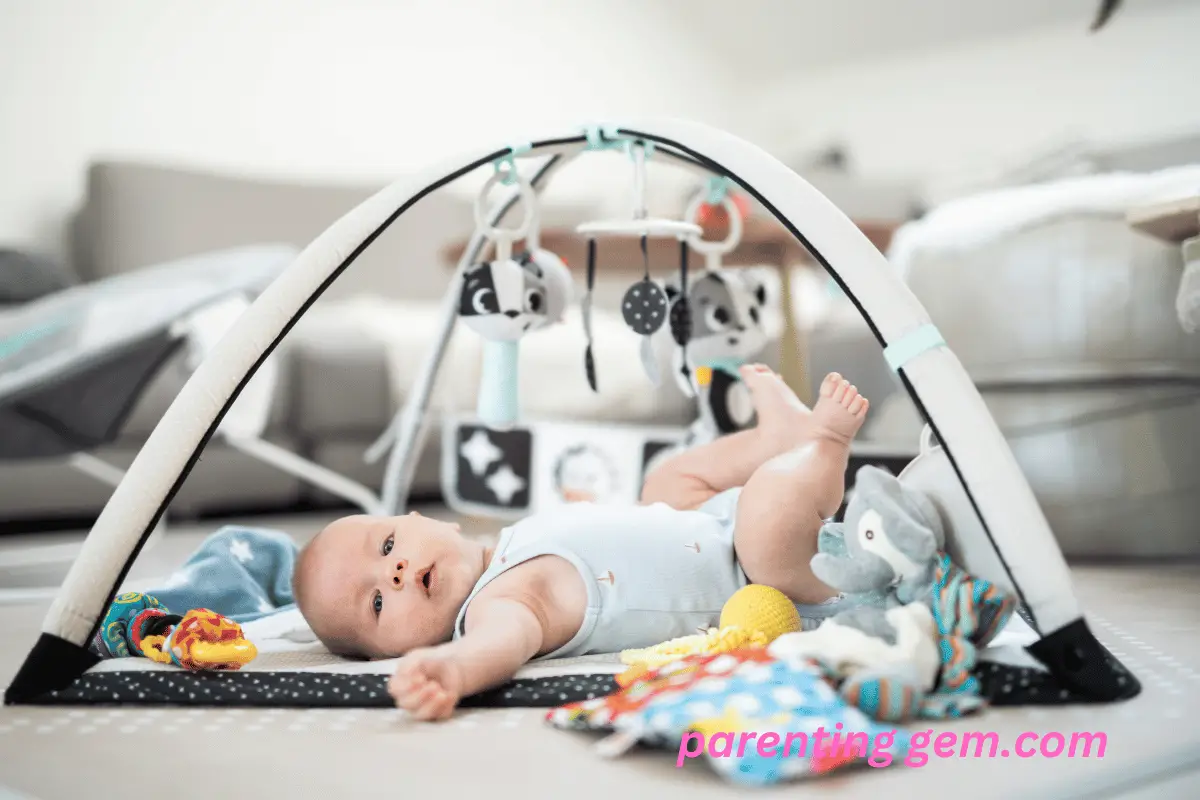As parents, seeing our children develop and learn daily brings joy. However, it can help to support their development in those critical early months and years, which can also feel overwhelming. Should we buy to help stimulate their growing minds and bodies in age-appropriate ways?
There are so many options on the market now that it’s easy to guess our choices. But have no fear; with some simple tips grounded in child development research, you can feel confident selecting playthings that genuinely enrich your baby’s world. In this post, I’ll break down the key factors to consider when choosing toys, from birth to toddlerhood, to help take the guesswork out of toy shopping and ensure your child’s playtime contributes maximally to their development.
Why Toys Are Important for Your Baby’s Development
Before we dive into the details of choosing toys, let’s first understand why they are so important for our little ones. Play is a crucial aspect of a child’s development, as it helps them learn about themselves and the world around them. It allows them to explore, experiment, and make sense of their environment, which is essential for their cognitive, social, emotional, and physical growth.
Toys are essential in facilitating this process as they provide opportunities for babies to engage in different types of play, such as sensory, imaginative, or fine motor activities. They also encourage children to use their creativity, problem-solving skills, and imagination to explore and learn. Furthermore, toys can help strengthen specific skills, such as hand-eye coordination, language development, and problem-solving abilities.
Therefore, choosing suitable toys for baby is crucial in supporting their developmental milestones and creating a fun and engaging learning experience. Now, let’s explore some key factors when selecting toys for your little one.
Age-Appropriate Toys
One of the essential considerations when choosing toys is ensuring they are suitable for your baby’s age and developmental stage. Age-appropriate toys are explicitly designed to meet a child’s current needs and abilities, making it easier for them to interact with and learn from the toy. For example, newborns will not benefit from a toy for toddlers as their motor skills and cognitive abilities are still developing.
To determine if a toy is age-appropriate, verify the recommended age on the packaging and take into account your child’s developmental level. Look for challenging toys that are easy for your child to use. This will guarantee that they are enthusiastic about learning while avoiding frustration.
Safety First
When it comes to selecting toys, safety should always be the top priority. Babies explore the world through their mouths, so it’s crucial to ensure that toys do not pose a choking hazard. Avoid small parts or pieces that can quickly come off and be swallowed. Additionally, look for toys made from non-toxic materials and those with no sharp edges or points.
It’s also worth considering any potential hazards in your home when choosing toys. For example, if you have older children who play with small toys, keep them out of your baby’s reach. Be cautious of any strings or cords that could also pose a strangulation risk.
Open-ended and Multi-Sensory Toys
Infants have a knack for being inquisitive and using their senses. Therefore, choosing toys that engage multiple senses and allow for open-ended play is essential. Toys that have multiple uses based on the child’s creativity and imagination are known as open-ended toys. These types of toys encourage children to use their problem-solving skills and foster their innate sense of curiosity.
Multi-sensory and open-ended toys include building blocks, shape sorters, and musical instruments. These types of toys stimulate multiple senses and allow for endless ways to play, making them excellent options for supporting your baby’s development.
Simple is Better
It can be tempting to choose flashy, high-tech toys with lots of bells and whistles, but research shows that simple toys often have more significant benefits for children’s development. Toys that do too much for the child can limit their creativity and imagination. Furthermore, simple toys are often less expensive and easier to clean.
Instead of focusing on flashy features, look for toys that allow your baby to use their imagination and pretend. This could include dolls, stuffed animals, or everyday objects like boxes, pots, and pans. These toys prompt children to create their own narratives and scenarios, essential for language development and social-emotional skills.
Rotate Toys
Babies are easily stimulated but can also get bored quickly. Rotating your baby regularly is an excellent idea to keep them engaged and interested in their toys. Putting away some toys for a few weeks and returning them can make them feel new and exciting again. Additionally, rotating toys can help prevent toy overload and ensure your child has a few options without feeling overwhelmed.
Follow Your Child’s Interests
Lastly, it’s important to remember that every child is unique and will have their interests and preferences regarding playtime. Observe your baby’s reactions to certain toys and pay attention to what they seem most drawn to. This can give you insight into their interests and help guide your toy selections.
Also, try different types of toys and activities to see what resonates with your child. It’s okay if they have favorites or specific interests – this can also evolve as they grow and develop.
Incorporating Toys in Everyday Activities
Toys can be included in regular activities outside of set playtime to assist your child’s learning and development further. For instance, you may utilize building blocks to reinforce counting or sorting skills during snack time or incorporate toy animals into bath time for imaginative play.
You can also involve your child in household chores by giving them a small broom or play vacuum to mimic your actions. This helps develop their motor skills and instills a sense of responsibility and independence. Additionally, toys like puzzles and shape sorters can be used during quiet time or before bedtime to wind down and promote problem-solving skills.
By incorporating toys into daily routines, you use the toys you already have and add a fun and educational element to everyday tasks. It’s a win-win for both parent and child! So don’t be afraid to get creative and think outside the box when incorporating toys into your child’s day. The possibilities are endless! Remember these critical factors when selecting toys, and you will provide your little one with a safe, engaging, and beneficial play experience.
A Guide to Selecting The Perfect Toys for Your Baby

Selecting the suitable toys for your baby plays a vital role in their development. Here are some essential tips to guide you:
- Prioritize Open-Ended Toys: Opt for toys like blocks, puzzles, and shape sorters that promote creativity and problem-solving. These toys allow for many ways to play, encouraging your child’s imagination and cognitive development.
- Materials Matter: Choose toys made from fabric, wood, or cardboard instead of plastic. These materials are safer and often more environmentally friendly.
- Interactive is Best: Toys that light up, play music, or involve some interaction can engage your baby’s sight and hearing, promoting sensory development.
- Everyday Items Can Be Toys: Don’t overlook everyday items as potential toys. Empty boxes, pots, pans, scarves, and books can provide endless amusement and learning opportunities.
- Challenge Physical Skills: As your baby grows, they will need toys that challenge their physical skills, like rattles, balls, and soft toys for grasping.
- Classic Toys Offer Value: Don’t stress about the latest toys. Simple, classic toys often provide the most learning and best value for money.
- Involve Your Baby in Toy Selection: Bring your baby to the store to test different toys and see what interests them.
- Toys That Develop Skills: Consider toys that develop specific skills, like stacking rings or nesting toys for hand-eye coordination.
- Limit Screen Time: For young babies, limit screen time and instead choose toys that encourage moving, exploring, and interacting with you.
- Rotate Your Baby’s Toys: Keep your baby’s curiosity alive by rotating their toys. This change can refresh their play experience and maintain their interest.
Remember, the goal is to provide a safe, engaging, and beneficial play experience that supports your child’s development. For more detailed guidance on selecting age-appropriate toys, please refer to this article by [AAP (American Academy of Pediatrics)], which offers valuable insights.
Final word
In conclusion, choosing suitable toys for your baby is essential for their development and learning. Keeping our main points in mind can provide our little ones with stimulating and engaging experiences. Remember to opt for open-ended toys that inspire creativity and problem-solving, and consider materials like fabric, wood, or cardboard for safety.
Remember to incorporate interactive toys that engage their sight and hearing or everyday items like boxes and scarves. As your baby grows, keep challenging them with age-appropriate toys that develop physical skills and hand-eye coordination. And let’s remember to involve our babies in the toy selection process – allow them to test out different options at the store and see what captures their interest.
And lastly, by rotating your baby’s toys, you can maintain their curiosity and keep things fresh for both of you! Thank you for checking out our post about selecting the best toys for your baby. We hope you found it informative and helpful.
We would love to hear from you – leave us a comment below sharing your thoughts or any other tips on selecting the perfect toys for young minds!

